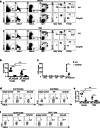Group 2 innate lymphoid cells are numerically and functionally deficient in the triple transgenic mouse model of Alzheimer's disease
- PMID: 34229727
- PMCID: PMC8261980
- DOI: 10.1186/s12974-021-02202-2
Group 2 innate lymphoid cells are numerically and functionally deficient in the triple transgenic mouse model of Alzheimer's disease
Abstract
Background: The immune pathways in Alzheimer's disease (AD) remain incompletely understood. Our recent study indicates that tissue-resident group 2 innate lymphoid cells (ILC2) accumulate in the brain barriers of aged mice and that their activation alleviates aging-associated cognitive decline. The regulation and function of ILC2 in AD, however, remain unknown.
Methods: In this study, we examined the numbers and functional capability of ILC2 from the triple transgenic AD mice (3xTg-AD) and control wild-type mice. We investigated the effects of treatment with IL-5, a cytokine produced by ILC2, on the cognitive function of 3xTg-AD mice.
Results: We demonstrate that brain-associated ILC2 are numerically and functionally defective in the triple transgenic AD mouse model (3xTg-AD). The numbers of brain-associated ILC2 were greatly reduced in 7-month-old 3xTg-AD mice of both sexes, compared to those in age- and sex-matched control wild-type mice. The remaining ILC2 in 3xTg-AD mice failed to efficiently produce the type 2 cytokine IL-5 but gained the capability to express a number of proinflammatory genes. Administration of IL-5, a cytokine produced by ILC2, transiently improved spatial recognition and learning in 3xTg-AD mice.
Conclusion: Our results collectively indicate that numerical and functional deficiency of ILC2 might contribute to the cognitive impairment of 3xTg-AD mice.
Keywords: Alzheimer’s disease (AD); Cognitive function; Group 2 innate lymphoid cells (ILC2); IL-5; Innate lymphoid cells (ILC).
Conflict of interest statement
Q.Y. reports a patent HRFM Ref. No. 0410.054AWO. The other authors declare that they have no competing interests.
Figures





References
-
- Gate D, Saligrama N, Leventhal O, Yang AC, Unger MS, Middeldorp J, Chen K, Lehallier B, Channappa D, De Los Santos MB, McBride A, Pluvinage J, Elahi F, Tam GK, Kim Y, Greicius M, Wagner AD, Aigner L, Galasko DR, Davis MM, Wyss-Coray T. Clonally expanded CD8 T cells patrol the cerebrospinal fluid in Alzheimer’s disease. Nature. 2020;577(7790):399–404. doi: 10.1038/s41586-019-1895-7. - DOI - PMC - PubMed
-
- Zhang Y, Fung ITH, Sankar P, Chen X, Robison LS, Ye L, D’Souza SS, Salinero AE, Kuentzel ML, Chittur SV, Zhang W, Zuloaga KL, Yang Q. Depletion of NK cells improves cognitive function in the Alzheimer disease mouse model. J Immunol. 2020;205(2):502–510. doi: 10.4049/jimmunol.2000037. - DOI - PMC - PubMed
MeSH terms
Grants and funding
LinkOut - more resources
Full Text Sources
Medical
Molecular Biology Databases

